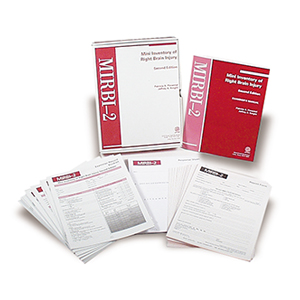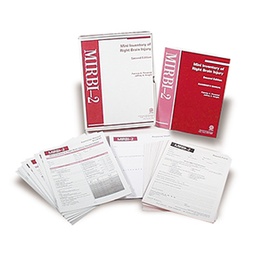MIRBI-2: Mini Inventory of Right Brain InjuryÐSecond Edition
The Mini Inventory of Right Brain Injury–Second Edition (MIRBI-2) lets you quickly screen clients for neurocognitive deficits associated with right hemisphere lesions. Its development meets the need for a brief, standardized, right-brain injury screening instrument that yields severity levels for deficit areas. Test reviews and professionals’ comments from the field were incorporated into the new edition.
Features of the MIRBI-2:
- More data were collected on normal and right- and left-brain-injured individuals.
- The number of cases in the interscorer reliability study was increased and relevant analyses were conducted on the expanded dataset.
- Many new validity studies have been conducted, with particular emphasis on the relationships of MIRBI-2 scores to other measures of neurocognitive impairment.
- A principal components factor analysis was performed to test construct validity of the items.
- Each item in the test was reevaluated using conventional item analysis to establish the underlying statistical foundation.
- A revised Right-Left Differential Scale was created with an updated cutoff score for right-brain impairment.
- A table for converting raw scores to percentiles and stanine scores was added.
- The rationale has been updated to reflect current trends in neuropsychology.
- The test booklet was revised to include more user-friendly areas for recording patient information, as well as revised criteria for scoring patient responses.
- A tear-off response pad has been added for additional convenience, featuring a response sheet for items 1 and 2 on one side, and the Reading Ability paragraph for completion of items 7 and 8 on the other.
The MIRBI-2 was normed on 128 right-brain injured people. Reliability was estimated by coefficient alpha (.84). All item discrimination coefficients exceeded .3 acceptable levels and ranged from .37 to .81, median: .57. Inter-rater reliability was .99. Concurrent validity was very good and included the study of left-brain injured participants and control participants without brain injury.




